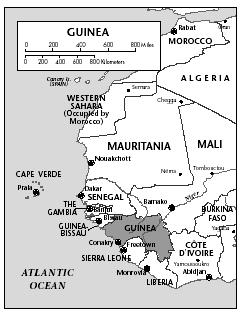Guinea - Rise to power
Lansana Conté succeeded Sékou Touré after Touré's death on an operating table in Cleveland, Ohio (where he was undergoing heart surgery) on 26 March 1984. Staging a bloodless coup, army officers created a military national recovery committee (CMRN) and took control of the government on 3 April 1984. The CMRN abolished the Constitution, banned the Democratic Party of Guinea (PDG), and announced the Second Republic. Having served as Touré's personal bodyguard, and being a member of a small ethnic group, Conté became the CMRN's choice to lead the country.
Opportunism and factionalism soon divided the CMRN, and a power struggle evolved between Conté and his prime minister, Colonel Diarra Traoré, who belonged to the same ethnic group as Sékou Touré. Traoré staged an aborted coup in July 1985, which led to reprisals against the mutineers and against the Malinke people. Shops were looted and some 50 Malinke officers died before firing squads.
The coup led by Diarra Traoré became a watershed event for ethnic politics. Trading on patronage, threats, and Conté's identity as a member of the minority Susu ethnic group, the Party for Unity and Progress (PUP) obtained votes across ethnic groups and won presidential, legislative, and municipal elections in 1993, 1995, 1998, and 2000. Conté survived a coup in February 1996 and following his disputed victory in December 1998, is serving out the remainder of a five-year term.

Comment about this article, ask questions, or add new information about this topic: